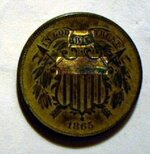MUD(S.W.A.T)
Gold Member
- Apr 15, 2005
- 8,003
- 898
- Detector(s) used
- I use, Whites MXT and Garrett AT Pro.
- Primary Interest:
- All Treasure Hunting
As some of you know I found a 1865 2 cent piece. It turns out that one side is at more of an angle than the otherside it was stamped turned. Anyone know how much of a value this will add if any? If you all want to see a pic just ask and I will post one.








